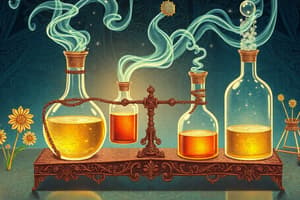Podcast
Questions and Answers
Which statement describes a chemical reaction as a process where atoms are rearranged without changing the number of atoms of each element?
Which statement describes a chemical reaction as a process where atoms are rearranged without changing the number of atoms of each element?
- An action that produces, consumes, or transforms matter.
- A process where atoms are rearranged without changing the number of atoms of each element. (correct)
- A transformation of substances through bond formation and breaking.
- Any event that causes atoms to gain, lose, share, or transfer electrons.
In a balanced chemical equation, what is the difference between reactants and products?
In a balanced chemical equation, what is the difference between reactants and products?
- Reactants contain fewer elements than products. (correct)
- All chemicals used are reactants, and none are products.
- Products have less mass than reactants.
- Reactants are ionic while products are covalent.
Why do chemical equations need to be balanced according to the Law of Conservation of Mass?
Why do chemical equations need to be balanced according to the Law of Conservation of Mass?
- Due to the requirements of stoichiometric analysis.
- To follow the Law of Conservation of Mass. (correct)
- Because atoms cannot appear or disappear during a reaction.
- Based on Avogadro's hypothesis.
What unit is appropriate for measuring the concentration of a substance in a chemical equation?
What unit is appropriate for measuring the concentration of a substance in a chemical equation?
Why are different states of matter often observed on opposite sides of a chemical equation?
Why are different states of matter often observed on opposite sides of a chemical equation?
What role do bonds play in chemical reactions?
What role do bonds play in chemical reactions?
Flashcards
Chemical reaction
Chemical reaction
A process where atoms are rearranged without changing their numbers.
Reactants vs Products
Reactants vs Products
Reactants contain fewer elements than products in a balanced equation.
Balancing chemical equations
Balancing chemical equations
Necessary to follow the Law of Conservation of Mass in reactions.
Unit for concentration
Unit for concentration
Signup and view all the flashcards
States of matter in equations
States of matter in equations
Signup and view all the flashcards
Role of bonds in reactions
Role of bonds in reactions
Signup and view all the flashcards
Study Notes
Multiple Choice Questions About Chemical Equations and Reactions
- Which statement correctly describes a chemical reaction? a) A process where atoms are rearranged without changing the number of atoms of each element. b) An action that produces, consumes, or transforms matter. c) A transformation of substances through bond formation and breaking. d) Any event that causes atoms to gain, lose, share, or transfer electrons.
- How are the numbers of atoms on both sides of a chemical equation equal after balancing the equation? a) According to the Law of Conservation of Mass. b) Based on Avogadro's hypothesis. c) Due to the requirements of stoichiometric analysis. d) Because atoms cannot appear or disappear during a reaction.
- In a balanced chemical equation, what is the difference between reactants and products? a) Reactants contain fewer elements than products. b) Products have less mass than reactants. c) Reactants are ionic while products are covalent. d) All chemicals used are reactants, and none are products.
- What is the appropriate unit for measuring the concentration of a substance in a chemical equation? a) Moles per liter. b) Grams per milliliter. c) Parts per million. d) Atomic mass units per gram.
- Why are different states of matter often seen on opposite sides of a chemical equation? a) So that the equation remains balanced. b) Because the states of matter can affect reaction rates. c) To account for phase transitions. d) As a symbolism rather than a requirement.
Studying That Suits You
Use AI to generate personalized quizzes and flashcards to suit your learning preferences.




